tires Hyundai Equus 2016 Owner's Manual
[x] Cancel search | Manufacturer: HYUNDAI, Model Year: 2016, Model line: Equus, Model: Hyundai Equus 2016Pages: 477, PDF Size: 16.25 MB
Page 19 of 477
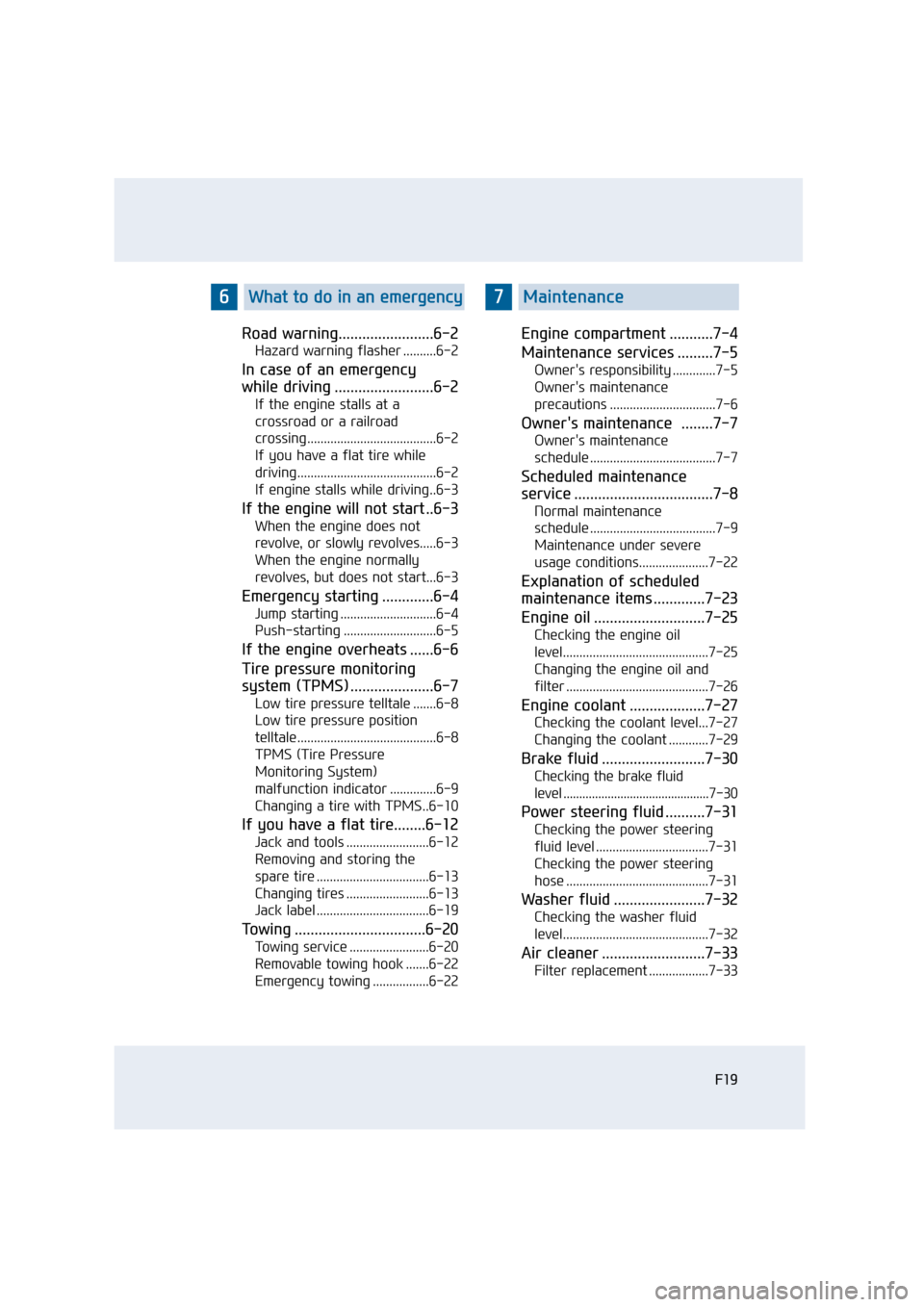
Road warning........................6-2
Hazard warning flasher ..........6-2
In case of an emergency
while driving .........................6-2
If the engine stalls at a
crossroad or a railroad
crossing.......................................6-2
If you have a flat tire while
driving..........................................6-2
If engine stalls while driving..6-3
If the engine will not start ..6-3
When the engine does not
revolve, or slowly revolves.....6-3
When the engine normally
revolves, but does not start...6-3
Emergency starting .............6-4
Jump starting .............................6-4
Push-starting ............................6-5
If the engine overheats ......6-6
Tire pressure monitoring
system (TPMS) .....................6-7
Low tire pressure telltale .......6-8
Low tire pressure position
telltale..........................................6-8
TPMS (Tire Pressure
Monitoring System)
malfunction indicator ..............6-9
Changing a tire with TPMS..6-10
If you have a flat tire........6-12
Jack and tools .........................6-12
Removing and storing the
spare tire ..................................6-13
Changing tires .........................6-13
Jack label ..................................6-19
Towing .................................6-20
Towing service ........................6-20
Removable towing hook .......6-22
Emergency towing .................6-22
Engine compartment ...........7-4
Maintenance services .........7-5
Owner's responsibility .............7-5
Owner's maintenance
precautions ................................7-6
Owner's maintenance ........7-7
Owner's maintenance
schedule ......................................7-7
Scheduled maintenance
service ...................................7-8
Normal maintenance
schedule ......................................7-9
Maintenance under severe
usage conditions.....................7-22
Explanation of scheduled
maintenance items .............7-23
Engine oil ............................7-25
Checking the engine oil
level............................................7-25
Changing the engine oil and
filter ...........................................7-26
Engine coolant ...................7-27
Checking the coolant level...7-27
Changing the coolant ............7-29
Brake fluid ..........................7-30
Checking the brake fluid
level ..............................................7-30
Power steering fluid ..........7-31
Checking the power steering
fluid level ..................................7-31
Checking the power steering
hose ...........................................7-31
Washer fluid .......................7-32
Checking the washer fluid
level............................................7-32
Air cleaner ..........................7-33
Filter replacement ..................7-33
F19
6What to do in an emergency7Maintenance
Page 20 of 477
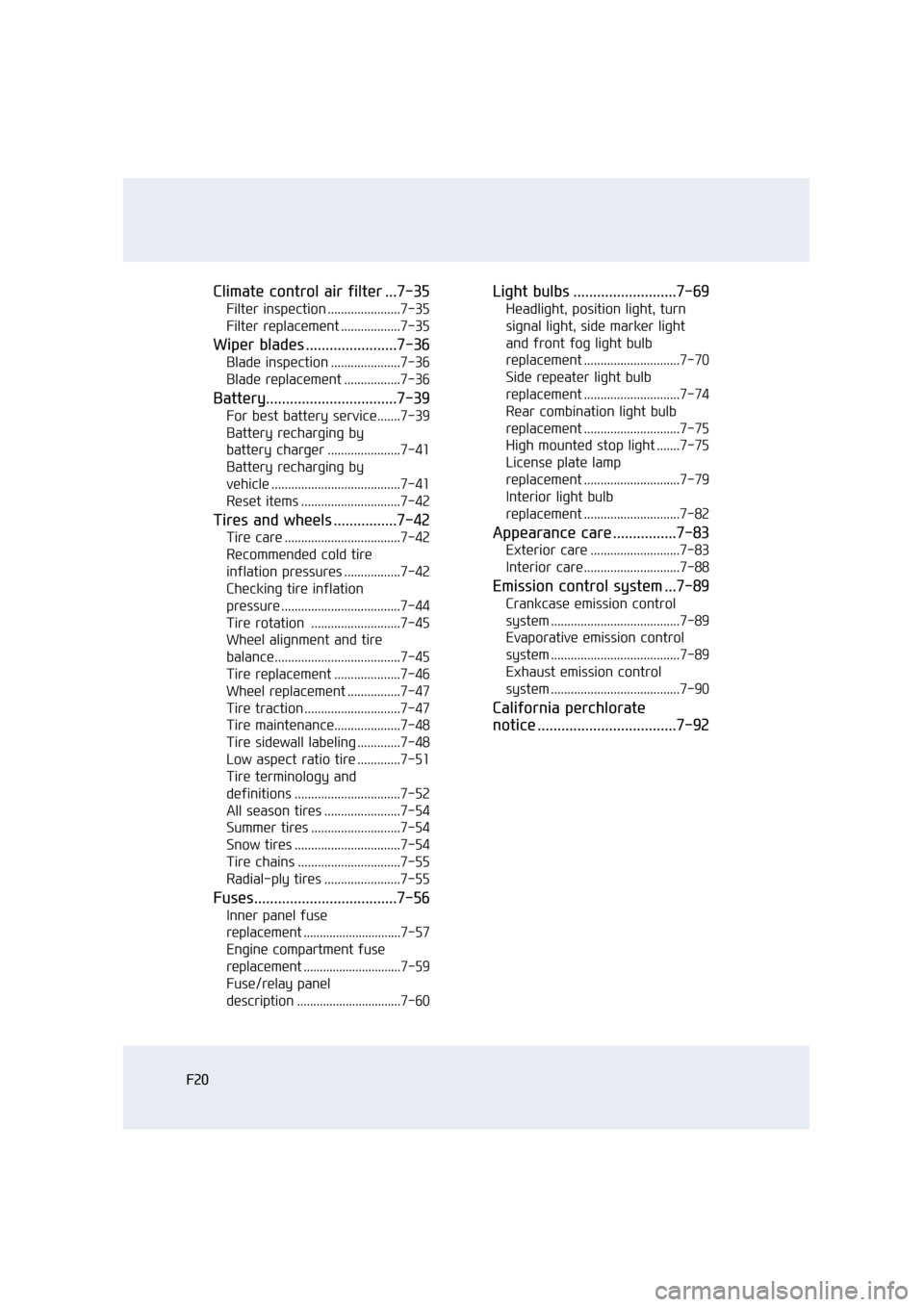
F20
Climate control air filter ...7-35
Filter inspection ......................7-35
Filter replacement ..................7-35
Wiper blades .......................7-36
Blade inspection .....................7-36
Blade replacement .................7-36
Battery.................................7-39
For best battery service.......7-39
Battery recharging by
battery charger ......................7-41
Battery recharging by
vehicle .......................................7-41
Reset items ..............................7-42
Tires and wheels ................7-42
Tire care ...................................7-42
Recommended cold tire
inflation pressures .................7-42
Checking tire inflation
pressure ....................................7-44
Tire rotation ...........................7-45
Wheel alignment and tire
balance......................................7-45
Tire replacement ....................7-46
Wheel replacement ................7-47
Tire traction .............................7-47
Tire maintenance....................7-48
Tire sidewall labeling .............7-48
Low aspect ratio tire .............7-51
Tire terminology and
definitions ................................7-52
All season tires .......................7-54
Summer tires ...........................7-54
Snow tires ................................7-54
Tire chains ...............................7-55
Radial-ply tires .......................7-55
Fuses....................................7-56
Inner panel fuse
replacement ..............................7-57
Engine compartment fuse
replacement ..............................7-59
Fuse/relay panel
description ................................7-60
Light bulbs ..........................7-69
Headlight, position light, turn
signal light, side marker light
and front fog light bulb
replacement .............................7-70
Side repeater light bulb
replacement .............................7-74
Rear combination light bulb
replacement .............................7-75
High mounted stop light .......7-75
License plate lamp
replacement .............................7-79
Interior light bulb
replacement .............................7-82
Appearance care ................7-83
Exterior care ...........................7-83
Interior care.............................7-88
Emission control system ...7-89
Crankcase emission control
system .......................................7-89
Evaporative emission control
system .......................................7-89
Exhaust emission control
system .......................................7-90
California perchlorate
notice ...................................7-92
Page 21 of 477
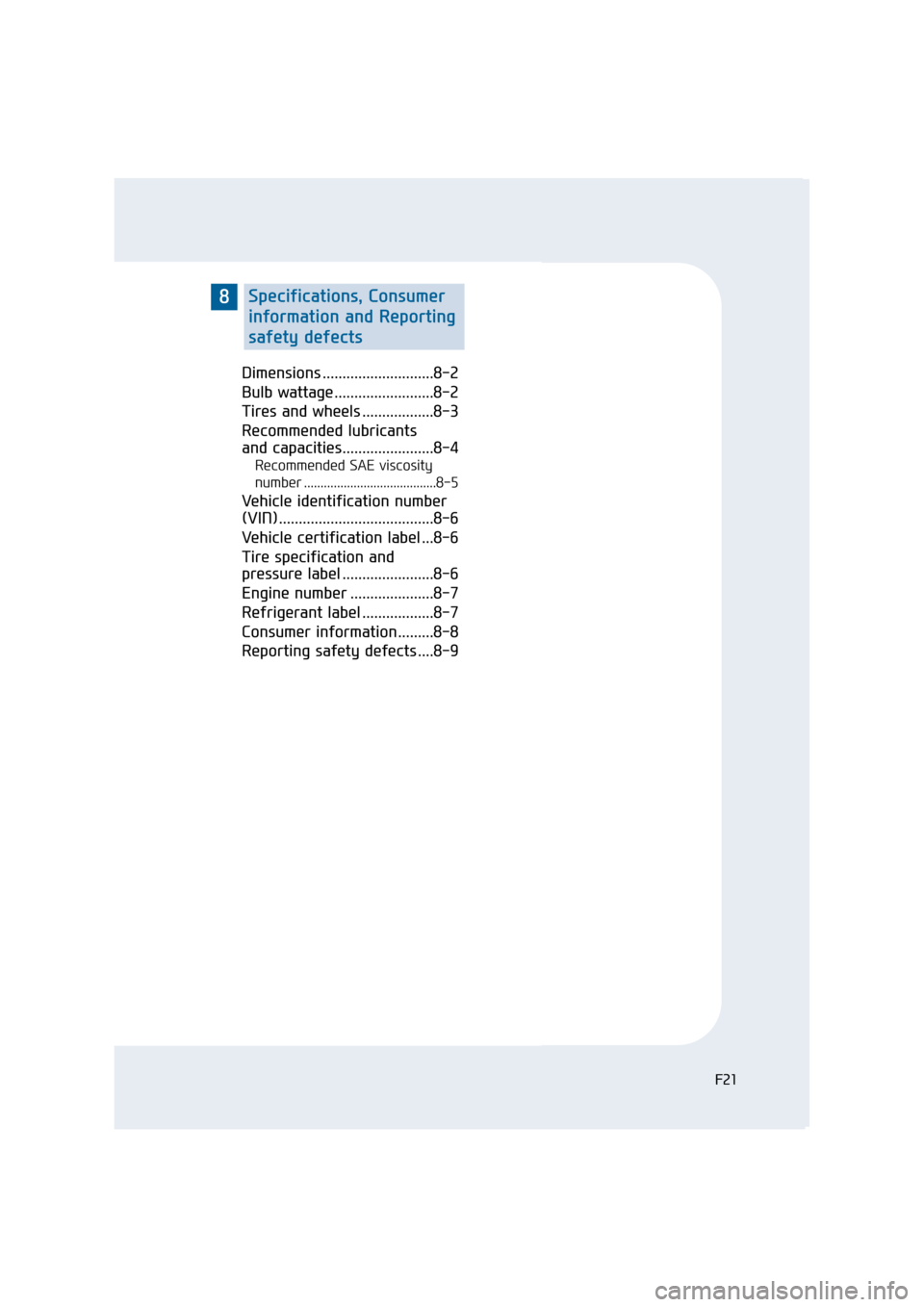
Dimensions ............................8-2
Bulb wattage .........................8-2
Tires and wheels ..................8-3
Recommended lubricants
and capacities.......................8-4
Recommended SAE viscosity
number ........................................8-5
Vehicle identification number
(VIN).......................................8-6
Vehicle certification label ...8-6
Tire specification and
pressure label .......................8-6
Engine number .....................8-7
Refrigerant label ..................8-7
Consumer information.........8-8
Reporting safety defects ....8-9
8Specifications, Consumer
information and Reporting
safety defects
F21
Page 22 of 477
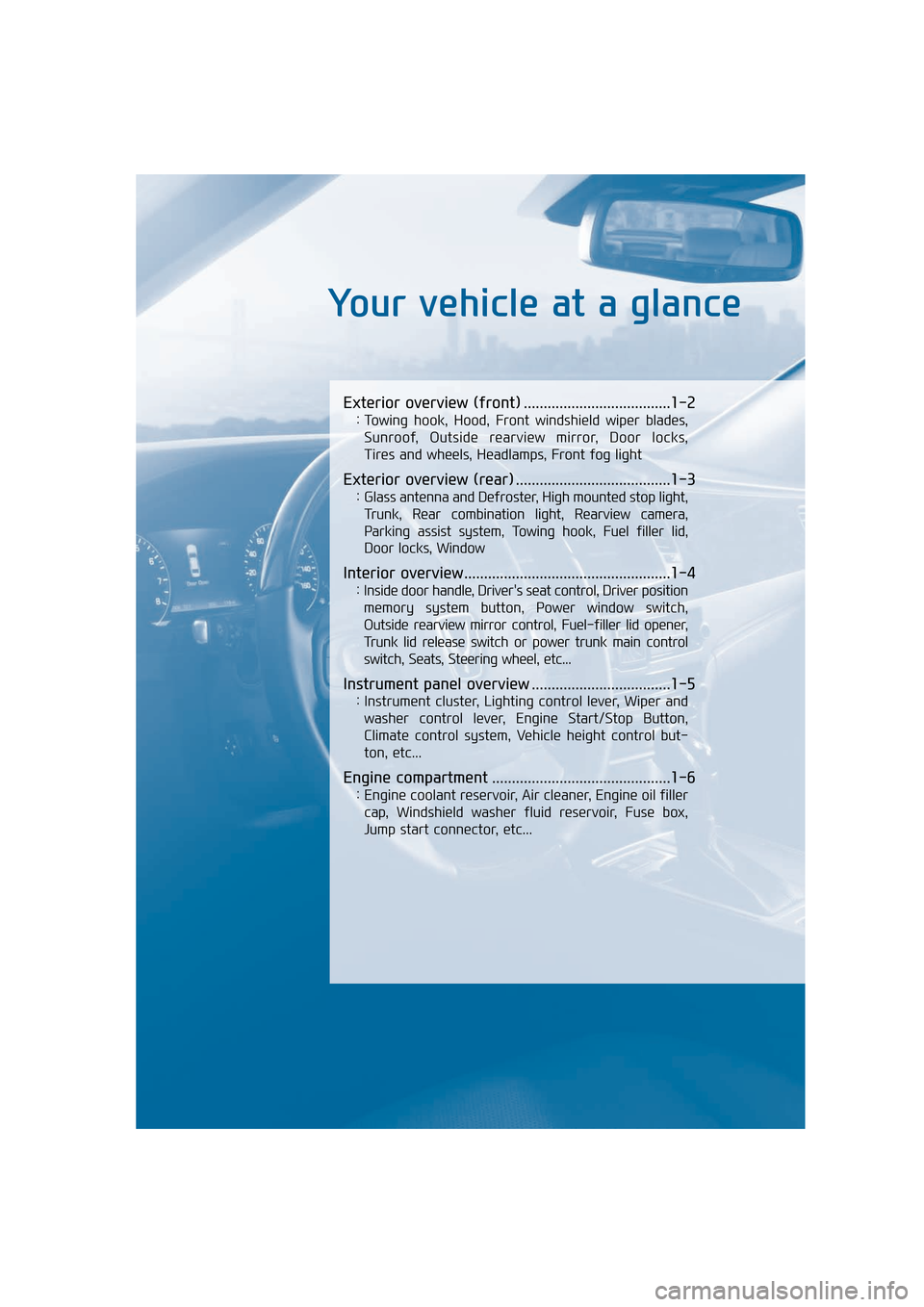
Your vehicle at a glance
Exterior overview (front) .....................................1-2
: Towing hook, Hood, Front windshield wiper blades, Sunroof, Outside rearview mirror, Door locks,
Tires and wheels, Headlamps, Front fog light
Exterior overview (rear) .......................................1-3
: Glass antenna and Defroster, High mounted stop light, Trunk, Rear combination light, Rearview camera,
Parking assist system, Towing hook, Fuel filler lid,
Door locks, Window
Interior overview ....................................................1-4
: Inside door handle, Driver's seat control, Driver position memory system button, Power window switch,
Outside rearview mirror control, Fuel-filler lid opener,
Trunk lid release switch or power trunk main control
switch, Seats, Steering wheel, etc...
Instrument panel overview ...................................1-5
: Instrument cluster, Lighting control lever, Wiper and washer control lever, Engine Start/Stop Button,
Climate control system, Vehicle height control but-
ton, etc...
Engine compartment .............................................1-6
: Engine coolant reservoir, Air cleaner, Engine oil fillercap, Windshield washer fluid reservoir, Fuse box,
Jump start connector, etc...
Page 23 of 477
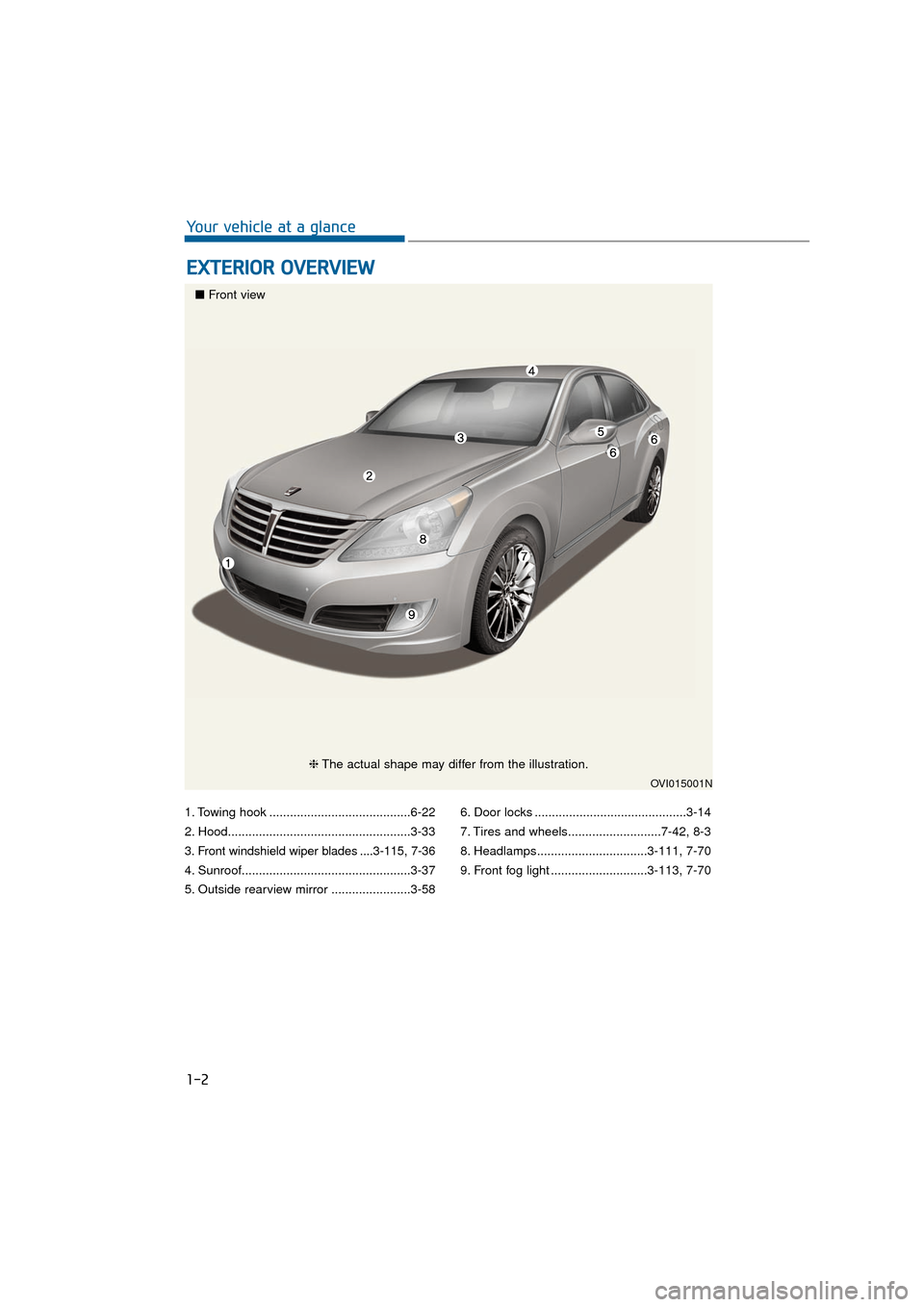
1. Towing hook .........................................6-22
2. Hood.....................................................3-33
3. Front windshield wiper blades ....3-115, 7-36
4. Sunroof.................................................3-37
5. Outside rearview mirror .......................3-586. Door locks ............................................3-14
7. Tires and wheels...........................7-42, 8-3
8. Headlamps................................3-111, 7-70
9. Front fog light ............................3-113, 7-70
E E
X
X T
TE
ER
R I
IO
O R
R
O
O V
VE
ER
R V
V I
IE
E W
W
1-2
Your vehicle at a glance
OVI015001N
■ Front view
❈The actual shape may differ from the illustration.
Page 189 of 477
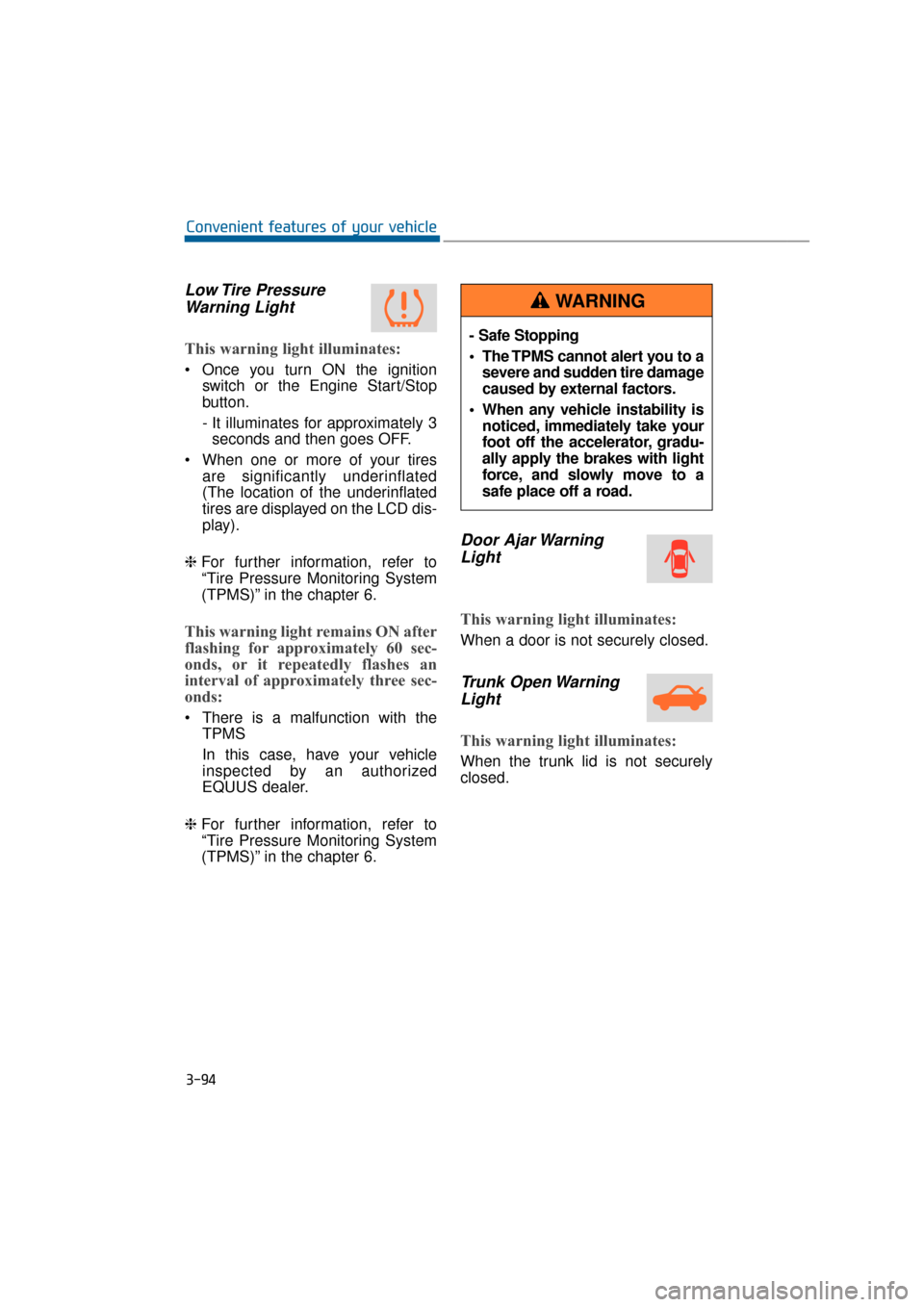
Low Tire PressureWarning Light
This warning light illuminates:
Once you turn ON the ignition
switch or the Engine Start/Stop
button.
- It illuminates for approximately 3seconds and then goes OFF.
When one or more of your tires are significantly underinflated
(The location of the underinflated
tires are displayed on the LCD dis-
play).
❈ For further information, refer to
“Tire Pressure Monitoring System
(TPMS)” in the chapter 6.
This warning light remains ON after
flashing for approximately 60 sec-
onds, or it repeatedly flashes an
interval of approximately three sec-
onds:
There is a malfunction with the
TPMS
In this case, have your vehicle
inspected by an authorized
EQUUS dealer.
❈ For further information, refer to
“Tire Pressure Monitoring System
(TPMS)” in the chapter 6.
Door Ajar Warning
Light
This warning light illuminates:
When a door is not securely closed.
Trunk Open WarningLight
This warning light illuminates:
When the trunk lid is not securely
closed.
3-94
Convenient features of your vehicle
- Safe Stopping
The TPMS cannot alert you to a
severe and sudden tire damage
caused by external factors.
When any vehicle instability is noticed, immediately take your
foot off the accelerator, gradu-
ally apply the brakes with light
force, and slowly move to a
safe place off a road.
WARNING
Page 256 of 477
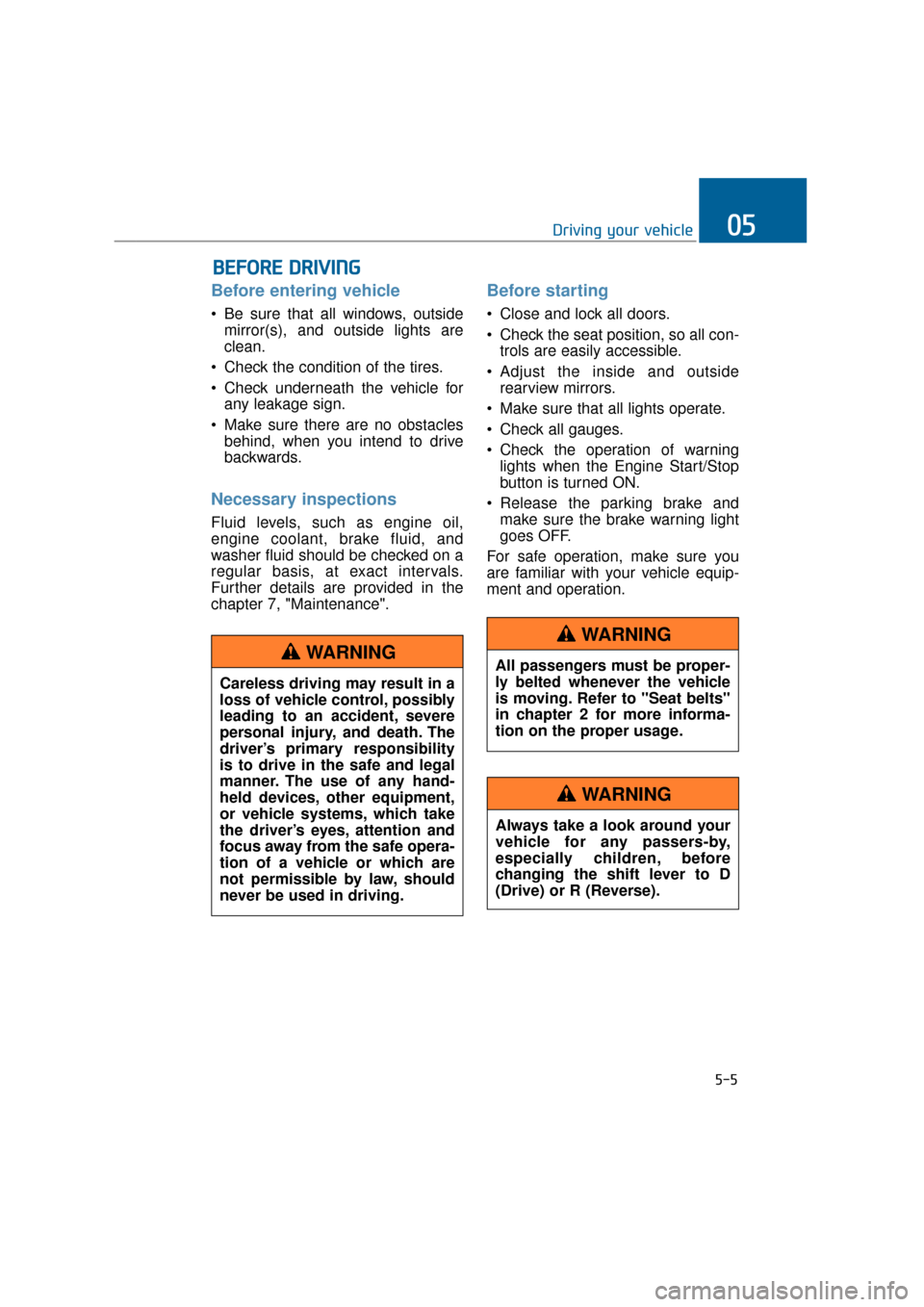
Before entering vehicle
• Be sure that all windows, outsidemirror(s), and outside lights are
clean.
Check the condition of the tires.
Check underneath the vehicle for any leakage sign.
Make sure there are no obstacles behind, when you intend to drive
backwards.
Necessary inspections
Fluid levels, such as engine oil,
engine coolant, brake fluid, and
washer fluid should be checked on a
regular basis, at exact intervals.
Further details are provided in the
chapter 7, "Maintenance".
Before starting
Close and lock all doors.
Check the seat position, so all con-trols are easily accessible.
Adjust the inside and outside rearview mirrors.
Make sure that all lights operate.
Check all gauges.
Check the operation of warning lights when the Engine Start/Stop
button is turned ON.
Release the parking brake and make sure the brake warning light
goes OFF.
For safe operation, make sure you
are familiar with your vehicle equip-
ment and operation.
B B E
EF
FO
O R
RE
E
D
D R
RI
IV
V I
IN
N G
G
5-5
Driving your vehicle05
Careless driving may result in a
loss of vehicle control, possibly
leading to an accident, severe
personal injury, and death. The
driver’s primary responsibility
is to drive in the safe and legal
manner. The use of any hand-
held devices, other equipment,
or vehicle systems, which take
the driver’s eyes, attention and
focus away from the safe opera-
tion of a vehicle or which are
not permissible by law, should
never be used in driving.
WARNINGAll passengers must be proper-
ly belted whenever the vehicle
is moving. Refer to "Seat belts"
in chapter 2 for more informa-
tion on the proper usage.
WARNING
Always take a look around your
vehicle for any passers-by,
especially children, before
changing the shift lever to D
(Drive) or R (Reverse).
WARNING
Page 282 of 477
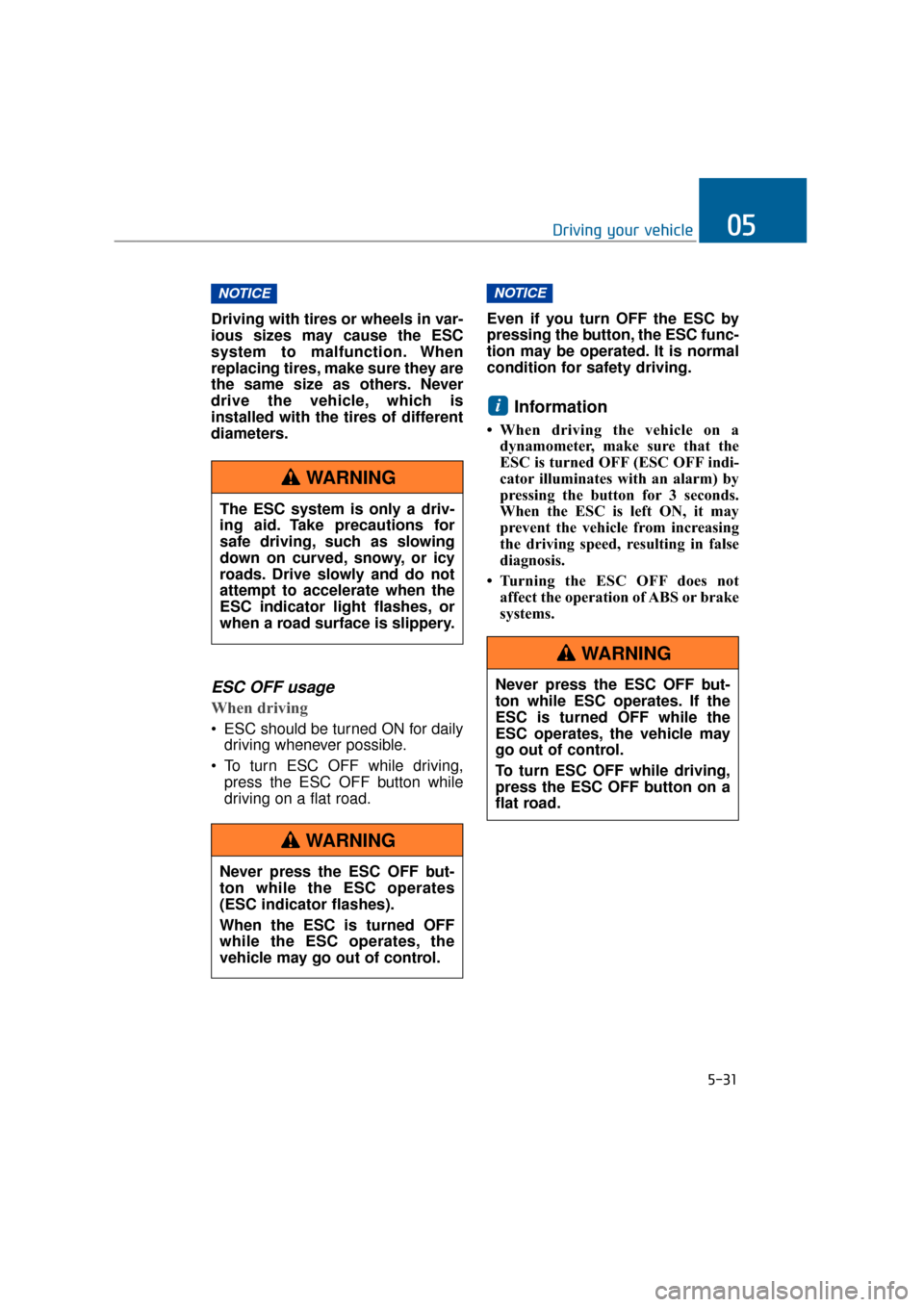
Driving with tires or wheels in var-
ious sizes may cause the ESC
system to malfunction. When
replacing tires, make sure they are
the same size as others. Never
drive the vehicle, which is
installed with the tires of different
diameters.
ESC OFF usage
When driving
ESC should be turned ON for dailydriving whenever possible.
To turn ESC OFF while driving, press the ESC OFF button while
driving on a flat road. Even if you turn OFF the ESC by
pressing the button, the ESC func-
tion may be operated. It is normal
condition for safety driving.
Information
• When driving the vehicle on a
dynamometer, make sure that the
ESC is turned OFF (ESC OFF indi-
cator illuminates with an alarm) by
pressing the button for 3 seconds.
When the ESC is left ON, it may
prevent the vehicle from increasing
the driving speed, resulting in false
diagnosis.
• Turning the ESC OFF does not affect the operation of ABS or brake
systems.
i
NOTICENOTICE
5-31
Driving your vehicle05
The ESC system is only a driv-
ing aid. Take precautions for
safe driving, such as slowing
down on curved, snowy, or icy
roads. Drive slowly and do not
attempt to accelerate when the
ESC indicator light flashes, or
when a road surface is slippery.
WARNING
Never press the ESC OFF but-
ton while ESC operates. If the
ESC is turned OFF while the
ESC operates, the vehicle may
go out of control.
To turn ESC OFF while driving,
press the ESC OFF button on a
flat road.
WARNING
Never press the ESC OFF but-
ton while the ESC operates
(ESC indicator flashes).
When the ESC is turned OFF
while the ESC operates, the
vehicle may go out of control.
WARNING
Page 318 of 477
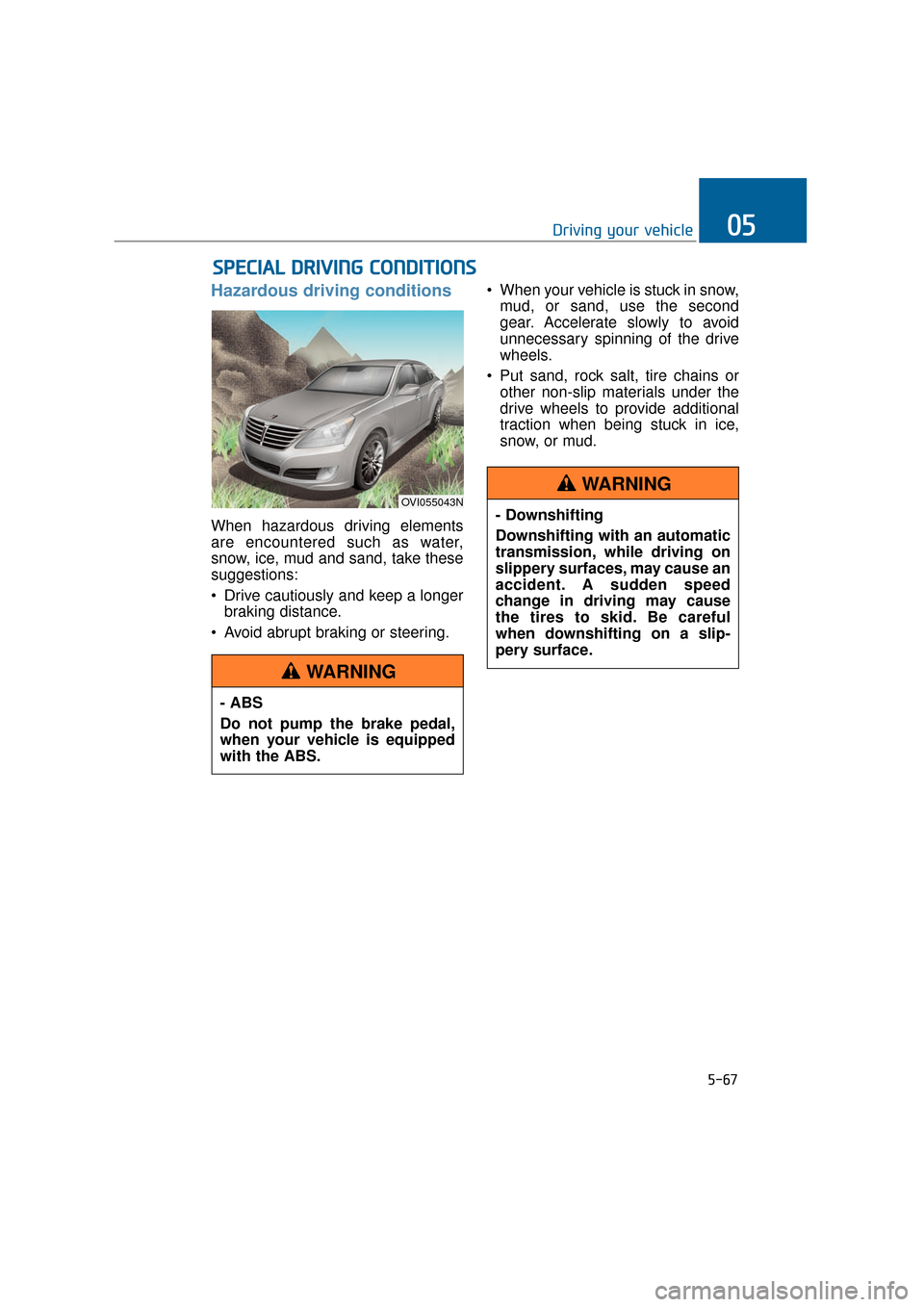
5-67
Driving your vehicle05
Hazardous driving conditions
When hazardous driving elements
are encountered such as water,
snow, ice, mud and sand, take these
suggestions:
Drive cautiously and keep a longerbraking distance.
Avoid abrupt braking or steering. When your vehicle is stuck in snow,
mud, or sand, use the second
gear. Accelerate slowly to avoid
unnecessary spinning of the drive
wheels.
Put sand, rock salt, tire chains or other non-slip materials under the
drive wheels to provide additional
traction when being stuck in ice,
snow, or mud.
S SP
P E
EC
CI
IA
A L
L
D
D R
RI
IV
V I
IN
N G
G
C
C O
O N
ND
DI
IT
T I
IO
O N
NS
S
OVI055043N
- ABS
Do not pump the brake pedal,
when your vehicle is equipped
with the ABS.
WARNING
- Downshifting
Downshifting with an automatic
transmission, while driving on
slippery surfaces, may cause an
accident. A sudden speed
change in driving may cause
the tires to skid. Be careful
when downshifting on a slip-
pery surface.
WARNING
Page 319 of 477
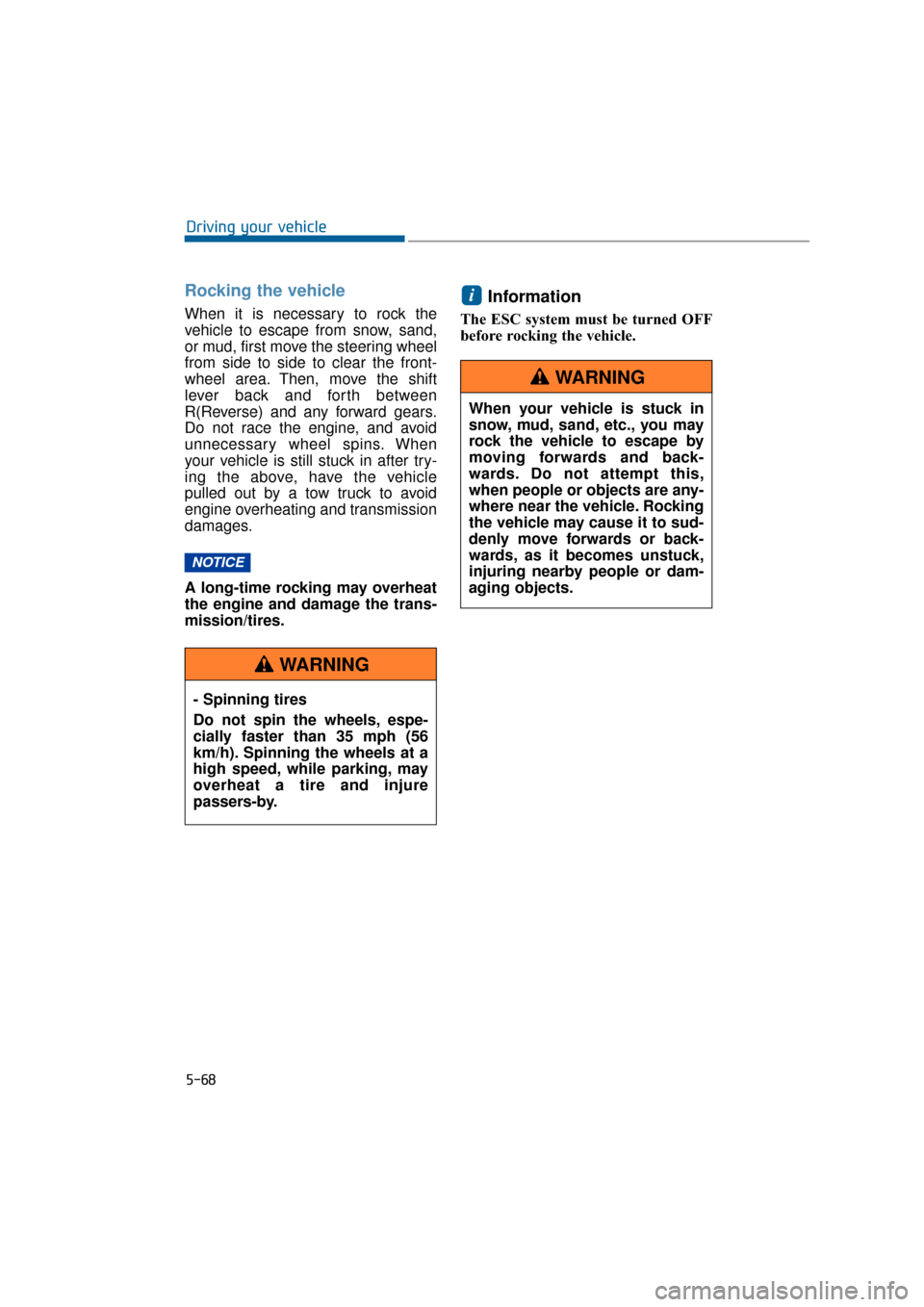
5-68
Driving your vehicle
Rocking the vehicle
When it is necessary to rock the
vehicle to escape from snow, sand,
or mud, first move the steering wheel
from side to side to clear the front-
wheel area. Then, move the shift
lever back and forth between
R(Reverse) and any forward gears.
Do not race the engine, and avoid
unnecessary wheel spins. When
your vehicle is still stuck in after try-
ing the above, have the vehicle
pulled out by a tow truck to avoid
engine overheating and transmission
damages.
A long-time rocking may overheat
the engine and damage the trans-
mission/tires.
Information
The ESC system must be turned OFF
before rocking the vehicle.
i
NOTICE
- Spinning tires
Do not spin the wheels, espe-
cially faster than 35 mph (56
km/h). Spinning the wheels at a
high speed, while parking, may
overheat a tire and injure
passers-by.
WARNING
When your vehicle is stuck in
snow, mud, sand, etc., you may
rock the vehicle to escape by
moving forwards and back-
wards. Do not attempt this,
when people or objects are any-
where near the vehicle. Rocking
the vehicle may cause it to sud-
denly move forwards or back-
wards, as it becomes unstuck,
injuring nearby people or dam-
aging objects.
WARNING